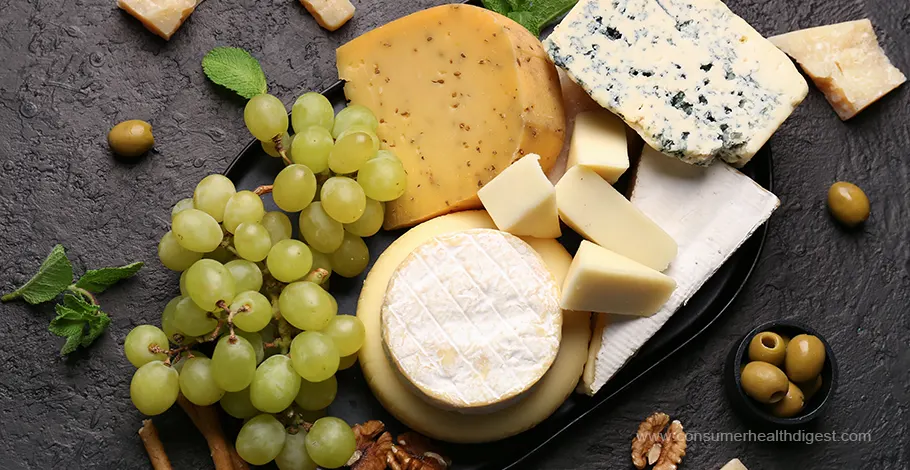Cheese, a ubiquitous presence on charcuterie boards and a beloved ingredient in countless dishes, holds a special place in our culinary world. Its rich textures, diverse flavors, and ability to elevate a simple meal are undeniable.

However, beneath this layer of deliciousness lies a potential health concern – the specific nutritional makeup of cheese can pose risks when consumed in excess. Despite the popular belief that eating cheese is harmful for health, this article delves into the science behind these risks, exploring how cheese impacts our health and how to navigate its consumption for a balanced diet[1].
The Double-Edged Sword of Saturated Fat:
One of the primary concerns with cheese lies in its high saturated fat content. An ounce of cheddar cheese, for example, packs a punch with around 6 grams of saturated fat. While dietary fat plays a crucial role in our bodies, saturated fat specifically has been linked to an increase in LDL cholesterol, often referred to as “bad” cholesterol. High LDL levels can lead to the buildup of plaque in arteries, increasing the risk of coronary heart disease and stroke.
However, the story of saturated fat and cheese is not entirely black and white. Recent research suggests that the saturated fat found in dairy products like cheese may be less detrimental than saturated fat from processed foods or red meat[2].
Additionally, some studies indicate that cheese consumption might even be associated with a lower risk of heart disease, although more research is needed to solidify this connection[3].
The Sodium Shuffle and Blood Pressure:
Another potential health risk associated with cheese is its high sodium content. Cheese can be a significant source of sodium, a mineral that helps regulate fluids in our bodies. However, excessive sodium intake can elevate blood pressure, a major risk factor for heart disease, stroke, and kidney disease. This is particularly concerning for individuals already struggling with hypertension or those who are genetically predisposed to high blood pressure.
The Lactose Lowdown:
For a significant portion of the population, cheese consumption presents a different challenge – lactose intolerance. Lactose, a sugar naturally found in milk, requires the enzyme lactase for proper digestion. Individuals with lactose intolerance lack sufficient lactase, leading to digestive discomfort like bloating, gas, and diarrhea after consuming dairy products, including cheese.
While some cheeses naturally have lower lactose content due to the aging process (e.g., cheddar, parmesan), complete lactose intolerance may necessitate avoiding cheese altogether.
Comparative Nutritional Analysis: The Cheeseboard’s Secrets

Different Types of Cheese
Mozzarella:
This versatile cheese is a champion of moderation. A one-ounce serving boasts a relatively low-fat content (around 4 grams) and a moderate amount of sodium (around 180 milligrams)[4]. However, mozzarella shines brightest in its calcium content, offering a whopping 18% of the Daily Value (DV) per ounce, making it a great choice for bone health.
Feta:
Often enjoyed crumbled atop salads or as part of a Mediterranean spread, feta offers a tangy flavor profile. However, be mindful of its sodium content. A single ounce can pack a punch with nearly 400 milligrams of sodium, exceeding 17% of the DV. On the positive side, feta is a good source of protein, offering around 6 grams per ounce, and boasts a lower fat content compared to some other cheeses (around 4 grams).
Goat Cheese:
This creamy cheese, often enjoyed spread on crackers or incorporated into dips, presents a unique nutritional profile. Goat cheese is naturally lower in lactose compared to cow’s milk cheeses, making it a potential option for those with mild lactose intolerance. It’s also relatively lower in fat (around 6 grams per ounce) when compared to some hard cheeses. However, keep in mind that goat cheese can still be high in sodium, with one ounce containing around 140 milligrams[5].
This is just a glimpse into the diverse nutritional landscape of cheeses. Remember, fat content can vary greatly depending on the cheese type (full-fat vs. low-fat). Additionally, aged cheeses tend to be lower in lactose due to the breakdown of lactose sugars during the aging process. By exploring these variations and keeping an eye on serving sizes, you can navigate the cheeseboard with confidence, selecting options that complement your dietary goals.
Beyond the Basics: Other Potential Concerns:
The potential health risks associated with cheese consumption extend beyond saturated fat, sodium, and lactose intolerance. Some studies suggest a possible link between high cheese intake and an increased risk of certain cancers, particularly prostate cancer.
However, these studies are often observational, and further research is needed to establish a definitive cause-and-effect relationship. Additionally, cheese can contribute to constipation, especially in children consuming large quantities of dairy products within a low-fiber diet.
Moderation is Key: Finding Balance in Your Cheese Consumption:

Finding Balance in Your Cheese
The information presented may paint a picture of cheese as a dietary villain. However, the reality is more nuanced. While cheese does have some drawbacks, it also offers potential benefits[6]. Cheese is a good source of calcium, essential for strong bones and teeth. It can also contribute to a healthy gut microbiome due to the presence of probiotics in some varieties.
The key to enjoying cheese without compromising your health lies in moderation. Despite the notion that eating cheese is harmful to health, incorporating it sensibly into your diet can offer enjoyment and nutritional benefits. Here are some tips:
Conclusion:
Cheese adds a delightful dimension to our culinary experiences. However, to truly savor its flavor without compromising our health, we must be aware of its potential downsides. By understanding the nutritional makeup of cheese, practicing moderation, and prioritizing a balanced diet, we can continue to enjoy cheese responsibly. Remember, cheese doesn’t have to be eliminated from your diet; it’s all about finding the right balance for optimal health and culinary enjoyment.
6 Sources
We review published medical research in respected scientific journals to arrive at our conclusions about a product or health topic. This ensures the highest standard of scientific accuracy.
[2] Food Sources of Saturated Fat and the Association With Mortality: A Meta-Analysis : https://www.ncbi.nlm.nih.gov/pmc/articles/PMC3966685/
[3] Effect of Cheese Intake on Cardiovascular Diseases and Cardiovascular Biomarkers : https://www.ncbi.nlm.nih.gov/pmc/articles/PMC9318947/
[4] Functional properties of Mozzarella cheese for its end use application : https://www.ncbi.nlm.nih.gov/pmc/articles/PMC5643830/
[5] Consumption of Goat Cheese Naturally Rich in Omega-3 and Conjugated Linoleic Acid Improves the Cardiovascular and Inflammatory Biomarkers of Overweight and Obese Subjects: A Randomized Controlled Trial : https://www.ncbi.nlm.nih.gov/pmc/articles/PMC7285099/
[6] Cheese as Functional Food: The Example of Parmigiano Reggiano and Grana Padano : https://www.ncbi.nlm.nih.gov/pmc/articles/PMC5654426/








 This article changed my life!
This article changed my life! This article was informative.
This article was informative. I have a medical question.
I have a medical question.
 This article contains incorrect information.
This article contains incorrect information. This article doesn’t have the information I’m looking for.
This article doesn’t have the information I’m looking for.